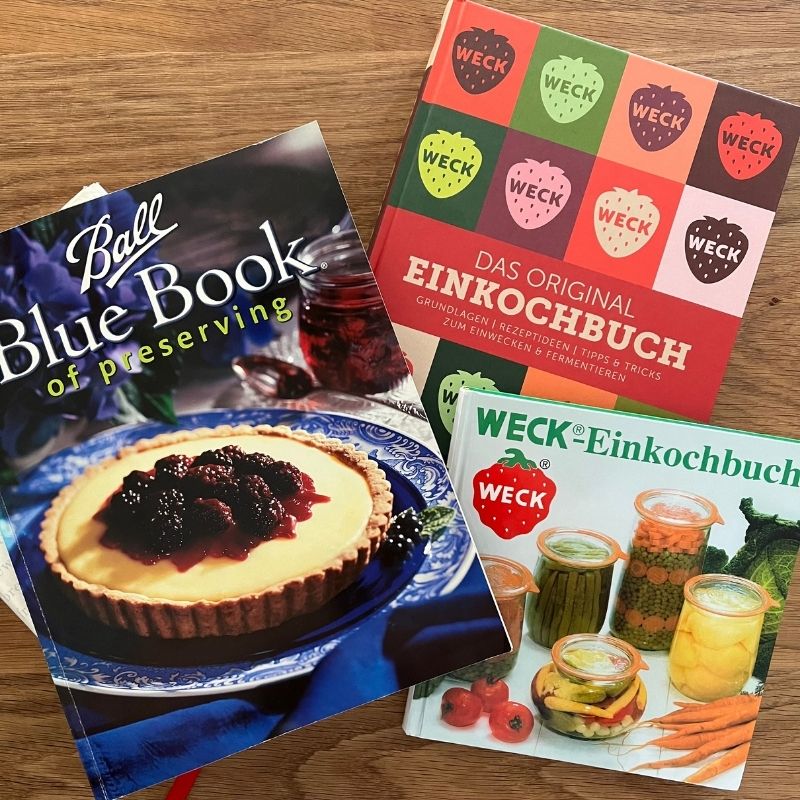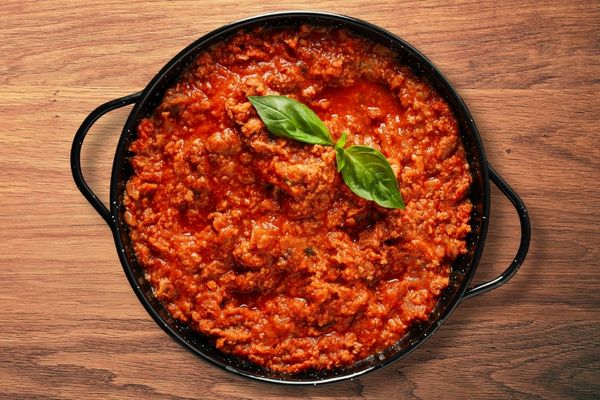It wasn’t supposed to be complicated. It’s just tomato sauce, right? But one thing led to another, and suddenly I was rethinking everything I previously knew about canning.
- Why I wanted to can Bolognese sauce
- In the U.S., meat sauces require a pressure canner
- Why canning without a pressure cooker is normal in Germany
- But doesn’t botulism require pressure? What the science says
- How I researched before ever canning a jar
- This blog began with one sauce and one question
- Frequently asked questions
If you’ve ever searched “Can you can spaghetti sauce with meat?” you’ve likely hit a wall of warnings. In the U.S., the USDA says it’s not safe without a pressure canner. But when I moved to Germany, I found something surprising: people here do it – routinely, and without pressure canners.
That contradiction launched my research journey into food canning in Germany and the layered safety system behind it. This post is the beginning of that story.
Why I wanted to can Bolognese sauce
Some recipes are good. Some are great. And then there are the ones you crave while standing in line at the store. My Bolognese sauce is that kind of recipe – slow-cooked with fresh ripe tomatoes, roasted aromatics, red wine, herbs, bacon, and beef. Rich, savory, unforgettable.
I like to make it in big batches and freeze the leftovers. But in our old apartment, the freezer was about the size of a shoebox, so we could never store much. When we moved to a house with a cellar and a real freezer, I thought I finally had enough space. For a while, I did – until the garden took over. Raspberries, blackberries, strawberries – the freezer was full again. The sauce was good, but the berries were sacred.
I needed a shelf-stable option. Something that didn’t depend on electricity, and wouldn’t melt into waste during a summer storm. I saw those jars not just as food, but as time and energy – garden work, cooking, clean-up – all saved for another day. And I wanted to keep them safe, even if the power went out.
In the U.S., meat sauces require a pressure canner
In American canning culture, one rule stands above the rest: low-acid foods must be pressure canned. That includes vegetables, soups, and yes – spaghetti sauce with meat.
It’s not just advice. It’s dogma. Taught in 4-H clubs, family kitchens, and official USDA guidance, it leaves no wiggle room. No pressure canner? No canned meat sauce.
So when I wanted to preserve my Bolognese, I went looking for a pressure canner in Germany.
Why canning without a pressure cooker is normal in Germany
Only one problem: you can’t find pressure canners here.
Not in the stores. Not online. Not even in another EU country, easy to import into Germany. At first, I thought it was just a market gap, but I was wrong. Germans do can – they just don’t use pressure. They use a system called Einkochen (boiling-water canning), and they’ve done it for more than a century.
And they don’t just can jam and high-acid foods. They preserve lentil soup, goulash, meat, even sausages – often in Weck jars, which you’ll find filled with hearty meals in farm shops and mainstream supermarkets alike.
It isn’t fringe. It isn’t rebellious. It’s just normal.

But doesn’t botulism require pressure? What the science says
This is where my scientific training kicked in. According to the USDA – and pretty much every canning site out there – Clostridium botulinum spores survive boiling. So how could Germans be doing this safely?
Why weren’t people getting sick? Why hadn’t the method been banned?
The contradiction was too big to ignore. My mom’s reaction? “You’re going to kill someone!” I get it – that fear is real. But I didn’t want to break rules. I wanted to understand them.
How I researched before ever canning a jar
I didn’t just jump in and start boiling spaghetti sauce in jars.
I read USDA materials. Then I read the German food safety guidelines from the Bundesinstitut für Risikobewertung (BfR). I dug into microbiology journals and watched German canning tutorials – sometimes replaying them three times to get the translation right.
In online forums across three countries, I watched home canners debate processing times, gasket styles, and spoilage detection. That’s where I first encountered the layered safety model: start with clean, fresh food. Boil for 90–120 minutes. Let jars sit six weeks. Check for signs of spoilage. Reheat if you open early.
It wasn’t guesswork. It was a system – consistent, layered, and trusted by generations. And once I understood that, I started to ask a bigger question.
This blog began with one sauce and one question
My question about canning spaghetti sauce with meat led me far beyond that first recipe. It opened up a deeper inquiry into how German canners ensure food safety without pressure – and why the USDA says otherwise.
This blog is the resource I wish I’d found when I first started questioning the rules. Here, I share what I discovered: the science, the tradition, the steps, and the logic behind each one. I won’t tell you what to do – but I’ll explain how it works, and why I trust it in my own kitchen.
If you’ve ever felt caught between rigid rules and real-world needs, you’re not alone.
Next up: Learn why I trust the German system – and how botulism really behaves in a jar.
Want the big picture? Check out my full guide to German water bath canning.
Frequently asked questions
Can you water bath can spaghetti sauce with meat?
In the U.S., the USDA advises that spaghetti sauce with meat should only be pressure canned, because of its low acidity. In Germany, however, many home canners preserve meat sauces safely using a traditional water bath system. This method combines several factors like long boiling times, careful cleanliness, and post-canning checks for spoilage that create a layered safety system. While it differs from USDA guidance, it has been used successfully in German households for generations.
Is canning without a pressure cooker ever safe?
Yes, canning without a pressure canner can be safe when it follows the right method. Germany’s traditional approach to water bath canning (Einkochen) relies on more than just boiling – it uses extended processing times, strict cleanliness, vacuum-seal checks, and in some cases reheating before use.
Why don’t Germans use pressure canners?
Pressure canners never became common in Germany because there was no need for them. German home canning developed around boiling-water processing and a layered safety approach that proved reliable for everyday kitchens. As a result, pressure canners were never marketed or adopted as standard household equipment. Instead, the tradition of Einkochen using water baths, long boiling, and spoilage detection became the norm.
Isn’t botulism a real risk?
Botulism is a real concern in home canning, but the risk can be effectively managed. The German water bath method addresses it with long boiling times that inactivate spores, strict cleanliness in preparation, and a strong emphasis on monitoring jars for spoilage before eating. By treating canning as a multi-step system rather than a single safeguard, this approach has maintained an excellent safety record in practice. Curious why botulism is feared in canning? Here’s the context and the science, simply explained.

Julie is a biologist turned science writer living in Germany. She shares her passion for traditional German water bath canning, seasonal cooking, and gardening on Old World Preserves.

